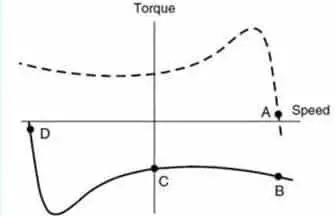Induction motors are one of the major power-consuming loads on the planet today and are widely used for all industrial and domestic applications. Plugging is one of the braking techniques performed in induction motors. Dynamic braking and regenerative braking are the other two braking methods.
What is meant by plugging an induction motor?
Plugging is the method of inducing negative torque in the rotor of an induction motor to rapidly bring its speed of rotation to zero. This is done by reversing the supply connection at the stator terminals. The reversal of the terminal connection of a motor running at a certain RPM reverses the current flow and the magnetic field in the armature which tends to generate a torque in the reverse direction thereby slowing the motor down, stopping it, and forcing it to rotate in the reverse direction.

Plugging a DC motor
Plugging is possible in DC motors also. All we need to do is to reverse the supply to armature terminals while the field supply remains unaltered. Reversal of the armature supply reverses the directions of the current flow and the magnetic field and the motor stops rapidly.
If the supply to the motor must be cut off as soon as the speed equals zero otherwise the motor starts accelerating in the opposite direction.
Drawbacks of plugging a motor
- One should never forget that a motor running at full speed induces a back EMF that is almost equal to the applied voltage. At the instant the motor is plugged, the direction of the back EMF and the applied voltage are in the same direction. Thus, the total stator voltage is almost double the rated voltage.
- While plugging, as the stator voltage doubles, there will be a sudden current inrush that could amount to up to twice the starting current.
- As mentioned earlier, the supply should be disconnected as soon as the motor comes to rest, otherwise, it will start accelerating in the opposite direction. Also, most of the time mechanical brakes need to be applied to stop it from spinning as soon as the speed drops to zero.
- The kinetic energy of the load as well as the energy supplied to the motor terminals is dissipated as heat in the rotor. This will result in the overheating of the rotor.
- The motor should be robust enough to withstand the electromechanical stresses caused while plugging.
Advantages
- The only advantage is that rapid stopping of the motor is possible.